All scores are claimed scores unless otherwise noted.
January: ARRL RTTY Roundup
•
QSOs: 1228
•
Mults: 97
•
Score: 119,116
•
Op Time: 21:48
My best score ever for this event.
I love this contest. My low power, dipole/vertical station plays best in North
American-centric contests so I typically don't put in much effort in contests where
DX multipliers or distance factor into the scoring. But for the RTTY RU where DX
mults only count once, not once per band, and all QSOs have the same point
total, I can make up for the shortcomings of my station by maxing out on operating
time. Those 22 hours in the chair were probably the most I have ever put into a
single event, and I was at the top of the online scoreboard for my category for much of the contest.
The bands were beautifully quiet but there did seem to be some weirdness going on with propagation as some loud stations were
difficult to work, especially on Saturday. I tried some different profiles in MMTTY and that seemed to help.
I had calls for 40 SMC members in my log and many of those were worked on multiple bands.
January: NAQP CW (Final Score)
•
QSOs: 922
•
Mults: 244
•
Score: 206,528
•
Op Time: 10 hours
First place Indiana and second place for the Central Division.
My first time breaking the 200k point threshold in this contest. I thought I might also
be able to get to the 1000 QSO level but ran out of time and steam.
Fatigue seemed to set in earlier than usual. Was it the great conditions and,
subsequently, the great rates early in the contest? I hope I was giving out the
Indiana multiplier to all those incredibly weak IL and WI stations on 15 and 20. I
really had to work to get you in the log on my end. There were also a number of
times that I had to quit S&Ping on the second radio and just run on the first radio as
my brain and ears needed a breather before jumping back in at full bore.
I use a call history file for this contest and I maintain my own rather than use the generic file that is available from the N1MM website,
as I find the error rate in the public file is uncomfortably high. But I won't be able to update my file with this running due to all those
Rods, Ellens, LNs, Freds and Bruces being used, as that would introduce too many inaccuracies for the next NAQP.
When the NCJ introduced an assisted category for this contest they should have also adjusted the team scoring to reflect the use of
assistance. Other things being equal, a team of 5 unassisted entrants will probably have a lower score than a team with 1 or more
assisted entrants.
And, is it my imagination, or is the WPM rate for this contest creeping up? I used to think you could chug along at 26 WPM and be in
the middle of the pack speed-wise. It seems that the average speed is more like 30 WPM now. Not sure what that means.
A fun but exhausting 10 hours, making this a good day to lie on the couch, do the crossword and watch football.
January: ARRL January VHF
•
QSOs: 6
•
Mults: 5
•
Score: 30
•
Op Time: Minuscule
Always hopeful of working a new grid but January tends to not be a good time to do that. I worked a couple of callsigns I knew but saw
some others I knew that I was unable to work, so band openings were very sporadic. Calling CQ netted a couple of more QSOs. All
QSOs were on FT8; nothing heard on the CW and SSB band segments.
January: CQ 160 CW
•
QSOs: 391
•
Points: 879
•
Mults: 52
•
Score: 45,708
•
Op Time: 7:25
A chance to snag some counters for the CWops ACA and CMA awards, along with
being a pleasant way to spend a few hours on the radio. Only worked 5 DX stations
and none of them were new for DX Challenge.
February: WPX RTTY at K9CT
•
QSOs: 4,001
•
Points: 10,865
•
Mults: 1,069
•
Score: 11,614,684
•
Op Time: 7:25
We topped our 2022 score but fell short of our all-
time record for this contest from 2017. From
K9CT’s summary to the SMC reflector:
“We had a great time! Matthew, KM9SPL joined
us for the first time. He is an EE student at
Bradley University and vice president of their ham
radio club, W9JWC. Connor, KD9LSV also joined
us and is a recent alumnus. CJ, WT2P joined un on the RTTY side for the first time. MIA were AI9T would just had heart surgery and
N9CK who had suddenly taken ill. All in all a great team effort.
“We enjoyed the online competition with WV4P team. Early back and forth kept us in our seats and totally focused!
“We operated using multFlex. Each station was two Maestros into a 6600, TGXL and PGXL. The partners had more antennas to
choose from this year adding new 10 and 15 OWA antennas and the 3 element yagi on 80m.
“Food was fantastic! Each team member brings food and drinks to share. No team member has lost weight!”
February: ARRL DX CW
•
QSOs: 54
•
Points: 162
•
Mults: 34
•
Score: 5,508
•
Op Time: 1:37
All S&P, looking for CWops members.
February: NAQP RTTY (Final Score)
•
QSOs: 722
•
Mults: 180
•
Score: 129.960
•
Op Time: 10:00
•
Team All Shook Up
NCJ added an assisted category to the NAQPs in 2022 but I stuck with the unassisted
category prior to this contest. I did some number crunching to see if I could gauge the
impact of assistance on scores, and I concluded that assisted stations do end up with
better scores when scores are adjusted for operating time. I wanted to contribute as
many points as I could for Team “All Shook Up” and for SMC towards the new version
of the NAQP Challenge. So, I turned on the telnet yesterday and I did beat my score from last February, but not by much.
I’ve always assumed that rates in this contest must drop in the last couple of hours since there is no 160. So, I started at 1800z, took a
half hour break at the 5 hour mark and then operated the next 5 hours. Which means that on Sunday morning, to paraphrase Elvis, my
hands were shaky, and my knees were weak, I couldn’t seem to stand on my own two feet.
March: Wisconsin QSO Party
•
CW QSOs: 29
•
SSB QSOs: 22
•
Mults: 32
•
Score: 3,840
It’s always subjective but it seemed like activity was down this year. WAAAAAY down. Could have been propagation but I saw
comments from others after the contest that reinforced the activity observation. As always, daytime activity was limited to 40 m and I
had limited time to operate during the 80 m window.
April: Florida QSO Party
•
CW QSOs: 71
•
Mults: 42
•
Score: 11,928
Mostly horsing around and working CWops members.
May: Indiana QSO Party
•
CW QSOs: 330
•
SSB QSOs: 70
•
Mults: 104
•
Score: 75,920
I no longer have my 2011 Nissan Rogue that served so well as an HF mobile. So,
2023 was planned as a portable operation from a rare county. That morphed into a
full time operation from home. Which morphed into a part time operation from
home. So the contest became more of an easy jog rather than a full-out sprint, and
not a bad way to spend a day.
The bands were dead the first half of the contest, as if every QSO partner was
operating QRP. Mid-contest they started to open up and by the end of the contest
they were pretty decent. Until the storms moved in, making 80 meters a steep
challenge I ended up with more breaks than I had planned and was forced to
unplug for the last hour of the contest. N1MM says I operated 7 of the 12 contest hours.
Every year I look at my INQP score and say, "I should have spent more time on phone." I knew that going into this one. Yet this year I
had only 70 phone QSOs, although half of those were mults, so I had quality if not quantity. Nevertheless, next year, I need to spend
more time on phone.
Thanks to the mobile, portable and rover stations. You activate a lot of counties that would not otherwise be available as mults.
May: 7QP
•
CW QSOs: 35
•
SSB QSOs: 41
•
Mults: 29
•
Score: 3,393
Runs concurrently with the INQP.
May: New England QSO Party
•
CW QSOs: 93
•
SSB QSOs: 11
•
Mults: 42
•
Score: 8,274
Runs concurrently with the INQP on Saturday, but continues on Sunday by itself. I logged an additional 44 NEWEQP QSOs on
Sunday
June: CQ WPX CW 40m
•
QSOs: 278
•
Points: 712
•
WPX: 225
•
Score: 160,200
Thought I would try a 40m low power effort, with a few QSOs on other bands to snag some CWops counters.
June: ARRL International Digital Contest
Band Mode QSOs Pts
14 FT4 159 816
14 FT8 75 575
21 FT4 116 1033
21 FT8 50 487
400 2911
Score: 2,911
Not a good contest for me due to the emphasis on distance/DX. And I was not much available in the evening. Why is it that FT8 still
predominates in these contests? If the band is open for FT8 it is open for FT4 with only a small loss of sensitivity.
June: Field Day
•
QSOs: 271
•
Points: 541
•
Score: 1,082
A 1D operation. I was unable to participate in the Lafayette DX Association Field Day since I was recovering from COVID. All CW
except for a 6m SSB QSO with LDXA as we we handling their traffic for bonuse points.
July: NAQP RTTY (Final Score)
•
QSOs: 516
•
Mults: 146
•
Score: 75,336
•
Op Time: 9:00
•
SMC Spotted Cow
Bands were brutal for the first couple of hours. I wore out the ink on my "AGN"
function key. And the lack of 10m activity meant no multipliers there: not a good
thing. Rates picked up once everyone moved to 40 and 80. I took 3 30-minute
breaks and then the last 1.5 hours as the rates were really dropping off towards
the end. But, despite all those negatives, this was still a Top Ten finish. So it
seems that others were suffering, too.
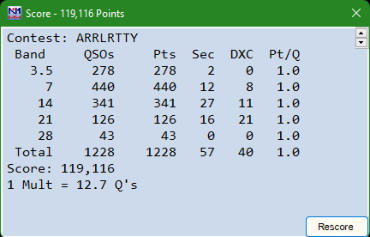
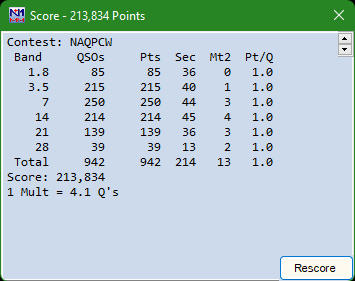
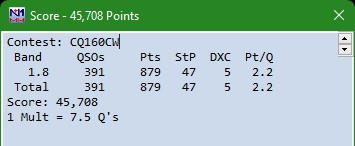
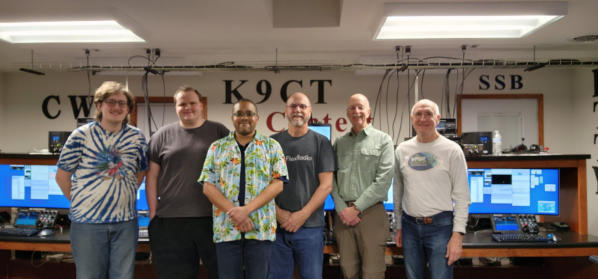
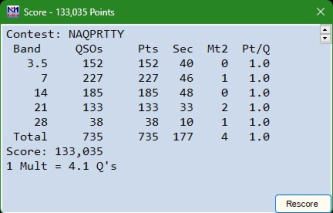
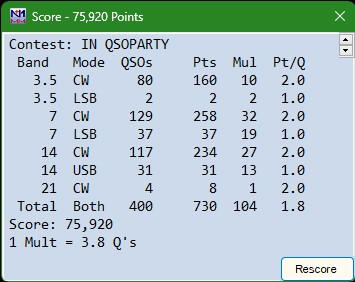

2023 Contest Results

K9WX Amateur Radio











